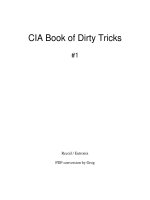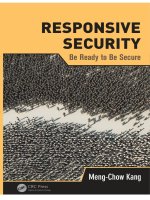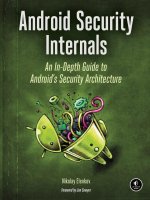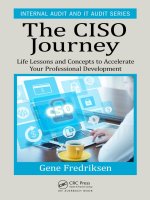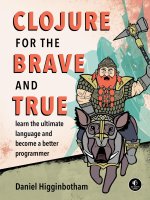Hacking ebook landoflisp learntoprgraminlisp
Bạn đang xem bản rút gọn của tài liệu. Xem và tải ngay bản đầy đủ của tài liệu tại đây (22.62 MB, 508 trang )
Lisp has been hailed as the world’s most powerful
programming language, but its cryptic syntax and
academic reputation can be enough to scare off
even experienced programmers. Those dark days
are finally over —
brings the power of
functional programming to the people!
Land of Lisp
With his brilliantly quirky comics and out-of-this-world
games, longtime Lisper Conrad Barski teaches you
the mysteries of Common Lisp. You’ll start with the
basics, like list manipulation, I/O, and recursion, then
move on to more complex topics like macros, higherorder programming, and domain-specific languages.
Then, when your brain overheats, you can kick back
with an action-packed comic book interlude!
Along the way you’ll create (and play) games
like Wizard’s Adventure, a text adventure with a
whiskey-soaked twist, and Grand Theft Wumpus, the
most violent version of Hunt the Wumpus the world
has ever seen.
You’ll learn to:
* Master the quirks of Lisp’s syntax and
semantics
* Write concise and elegant functional programs
* Use macros, create domain-specific
languages, and learn other advanced Lisp
techniques
* Create your own web server and use it to
play browser-based games
* Put your Lisp skills to the test by writing brainmelting games like Dice of Doom and Orc
Battle
Land of Lisp
With
, the power of functional
programming is yours to wield.
T H E F I N E ST I N G E E K E N T E RTA I N M E N T ™
w w w.nostarch.com
“ I L I E F L AT .”
This book uses a lay-flat binding that won't snap shut.
FSC LOGO
$49.95
($57.95 CDN)
shelve in: programming languages/lisp
Barski
Games! Comics! Programming!
Conrad Barski, M.D.
Lisp_02.book Page i Wednesday, January 5, 2011 11:18 AM
LAND OF LISP
Lisp_02.book Page ii Wednesday, January 5, 2011 11:18 AM
Lisp_02.book Page iii Wednesday, January 5, 2011 11:18 AM
LAND OF LISP
Learn to Program in Lisp,
One Game at a Time!
by Conrad Barski, M.D.
San Francisco
Lisp_02.book Page iv Wednesday, January 5, 2011 11:18 AM
LAND OF LISP. Copyright © 2011 by Conrad Barski, M.D.
All rights reserved. No part of this work may be reproduced or transmitted in any form or by any means, electronic or
mechanical, including photocopying, recording, or by any information storage or retrieval system, without the prior
written permission of the copyright owner and the publisher.
Printed in Canada
14 13 12 11 10
123456789
ISBN-10: 1-59327-281-2
ISBN-13: 978-1-59327-281-4
Publisher: William Pollock
Production Editors: Ansel Staton and Serena Yang
Developmental Editor: Keith Fancher
Technical Reviewers: Philip Fominykh and Heow Eide-Goodman
Copyeditor: Marilyn Smith
Compositor: Susan Glinert Stevens
Proofreader: Linda Seifert
Indexer: Nancy Guenther
For information on book distributors or translations, please contact No Starch Press, Inc. directly:
No Starch Press, Inc.
38 Ringold Street, San Francisco, CA 94103
phone: 415.863.9900; fax: 415.863.9950; ; www.nostarch.com
Library of Congress Cataloging-in-Publication Data
Barski, Conrad.
Land of Lisp : learn to program in Lisp, one game at a time! / by Conrad Barski.
p. cm.
Includes index.
ISBN-13: 978-1-59327-281-4
ISBN-10: 1-59327-281-2
1. Computer games--Programming 2. COMMON LISP (Computer program language) 3. LISP (Computer program language)
I. Title.
QA76.76.C672B3693 2010
794.8'1526--dc22
2010026755
No Starch Press and the No Starch Press logo are registered trademarks of No Starch Press, Inc. Other product and
company names mentioned herein may be the trademarks of their respective owners. Rather than use a trademark
symbol with every occurrence of a trademarked name, we are using the names only in an editorial fashion and to the
benefit of the trademark owner, with no intention of infringement of the trademark.
The information in this book is distributed on an “As Is” basis, without warranty. While every precaution has been
taken in the preparation of this work, neither the author nor No Starch Press, Inc. shall have any liability to any
person or entity with respect to any loss or damage caused or alleged to be caused directly or indirectly by the
information contained in it.
Lisp_02.book Page v Wednesday, January 5, 2011 11:18 AM
For Lauren
Lisp_02.book Page vi Wednesday, January 5, 2011 11:18 AM
Lisp_02.book Page vii Wednesday, January 5, 2011 11:18 AM
BRIEF CONTENTS
Acknowledgments ........................................................................................................xvii
Introduction ....................................................................................................................1
SECTION I: LISP IS POWER
Chapter 1: Getting Started with Lisp ................................................................................15
Chapter 2: Creating Your First Lisp Program .....................................................................21
Chapter 3: Exploring the Syntax of Lisp Code...................................................................31
SECTION II: LISP IS SYMMETRY
Chapter 4: Making Decisions with Conditions ..................................................................49
Chapter 5: Building a Text Game Engine .........................................................................67
Chapter 6: Interacting with the World: Reading and Printing in Lisp ....................................85
Chapter 6.5: lambda: A Function So Important It Deserves Its Own Chapter.......................103
Chapter 7: Going Beyond Basic Lists .............................................................................107
Chapter 8: This Ain’t Your Daddy’s Wumpus..................................................................129
Chapter 9: Advanced Datatypes and Generic Programming ............................................153
Lisp_02.book Page viii Wednesday, January 5, 2011 11:18 AM
SECTION III: LISP IS HACKING ..................................................................................191
Chapter 10: Looping with the loop Command ................................................................195
Chapter 11: Printing Text with the format Function...........................................................221
Chapter 12: Working with Streams ...............................................................................237
Chapter 13: Let’s Create a Web Server! ........................................................................253
Functional Programming Is Beautiful ..............................................................................269
SECTION IV: LISP IS SCIENCE
Chapter 14: Ramping Lisp Up a Notch with Functional Programming ................................291
Chapter 15: Dice of Doom, a Game Written in the Functional Style ..................................303
Chapter 16: The Magic of Lisp Macros ..........................................................................339
Chapter 17: Domain-Specific Languages........................................................................355
Chapter 18: Lazy Programming ....................................................................................375
Chapter 19: Creating a Graphical, Web-Based Version of Dice of Doom ..........................401
Chapter 20: Making Dice of Doom More Fun.................................................................417
Epilogue ....................................................................................................................429
Index .........................................................................................................................465
viii
Brief Contents
Lisp_02.book Page ix Wednesday, January 5, 2011 11:18 AM
CONTENTS IN DETAIL
A C KN O W L E D G M E N T S
INTRODUCTION
xvii
1
What Makes Lisp So Cool and Unusual? .................................................................... 2
If Lisp Is So Great, Why Don’t More People Use It? ...................................................... 3
Where Did Lisp Come From? ..................................................................................... 4
Where Does Lisp Get Its Power? .............................................................................. 10
SECTION I: LISP IS POWER
1
G E T T I N G S T A R T E D W IT H L I S P
15
Lisp Dialects .......................................................................................................... 15
A Tale of Two Lisps ................................................................................... 16
Up-and-Coming Lisps ................................................................................. 17
Lisp Dialects Used for Scripting ................................................................... 17
ANSI Common Lisp ................................................................................... 17
Getting Started with CLISP ....................................................................................... 18
Installing CLISP ......................................................................................... 18
Starting Up CLISP ...................................................................................... 19
What You’ve Learned ............................................................................................. 19
2
CREATING YOUR FIRST LISP PROGRAM
21
The Guess-My-Number Game .................................................................................. 21
Defining Global Variables in Lisp ............................................................................. 23
Defining the small and big Variables ........................................................... 23
An Alternative Global Variable Definition Function ........................................ 23
Basic Lisp Etiquette ................................................................................................. 24
Defining Global Functions in Lisp ............................................................................. 25
Defining the guess-my-number Function ........................................................ 25
Defining the smaller and bigger Functions .................................................... 27
Defining the start-over Function ................................................................... 28
Defining Local Variables in Lisp ................................................................................ 28
Defining Local Functions in Lisp ................................................................................ 29
What You’ve Learned ............................................................................................. 30
Lisp_02.book Page x Wednesday, January 5, 2011 11:18 AM
3
E X P L O R I N G T H E S Y N TA X O F L I S P C O D E
31
Syntax and Semantics ............................................................................................. 31
The Building Blocks of Lisp Syntax ............................................................................ 32
Symbols ................................................................................................... 33
Numbers .................................................................................................. 34
Strings ..................................................................................................... 35
How Lisp Distinguishes Between Code and Data ........................................................ 35
Code Mode .............................................................................................. 36
Data Mode ............................................................................................... 37
Lists in Lisp ............................................................................................................ 37
Cons Cells ................................................................................................ 38
List Functions ............................................................................................. 38
Nested Lists .............................................................................................. 41
What You’ve Learned ............................................................................................. 45
SECTION II: LISP IS SYMMETRY
4
M AK I N G D E C I S I O N S W I T H C O N D I T I O N S
49
The Symmetry of nil and () ....................................................................................... 49
Empty Equals False .................................................................................... 50
The Four Disguises of () .............................................................................. 51
The Conditionals: if and Beyond .............................................................................. 52
One Thing at a Time with if ........................................................................ 52
Going Beyond if: The when and unless Alternatives ....................................... 55
The Command That Does It All: cond ........................................................... 56
Branching with case .................................................................................. 57
Cool Tricks with Conditions ..................................................................................... 58
Using the Stealth Conditionals and and or .................................................... 58
Using Functions That Return More than Just the Truth ...................................... 60
Comparing Stuff: eq, equal, and More ..................................................................... 62
What You’ve Learned ............................................................................................. 65
5
B U I L D IN G A T E X T G A M E E N G I N E
67
The Wizard’s Adventure Game ................................................................................ 68
Our Game World ..................................................................................... 68
Basic Requirements .................................................................................... 69
Describing the Scenery with an Association List .......................................................... 70
Describing the Location ........................................................................................... 71
Describing the Paths ............................................................................................... 72
How Quasiquoting Works .......................................................................... 73
Describing Multiple Paths at Once ............................................................... 73
Describing Objects at a Specific Location .................................................................. 77
Listing Visible Objects ................................................................................ 77
Describing Visible Objects ......................................................................... 78
x
Contents in D etai l
Lisp_02.book Page xi Wednesday, January 5, 2011 11:18 AM
Describing It All ..................................................................................................... 79
Walking Around in Our World ................................................................................ 81
Picking Up Objects ................................................................................................. 82
Checking Our Inventory .......................................................................................... 83
What You’ve Learned ............................................................................................. 84
6
INTERACTING WITH THE WORLD:
R E A D I N G A N D P R IN T I N G I N L IS P
85
Printing and Reading Text ....................................................................................... 86
Printing to the Screen ................................................................................. 86
Saying Hello to the User ........................................................................... 87
Starting with print and read ........................................................................ 88
Reading and Printing Stuff the Way Humans Like It ........................................ 90
The Symmetry Between Code and Data in Lisp ........................................................... 91
Adding a Custom Interface to Our Game Engine ....................................................... 92
Setting Up a Custom REPL .......................................................................... 93
Writing a Custom read Function ................................................................. 94
Writing a game-eval Function ..................................................................... 96
Writing a game-print Function .................................................................... 96
Trying Out Our Fancy New Game Interface .............................................................. 99
The Dangers of read and eval ............................................................................... 101
What You’ve Learned ........................................................................................... 101
6.5
LAMBDA: A FUNCTION SO IMPORTANT IT DESERVES
I T S O W N C H A PT E R
103
What lambda Does .............................................................................................. 103
Why lambda Is So Important ................................................................................. 105
What You’ve Learned ........................................................................................... 106
7
G O IN G B E Y O N D B AS IC L I S T S
107
Exotic Lists ........................................................................................................... 107
Dotted Lists ............................................................................................. 108
Pairs ...................................................................................................... 109
Circular Lists ........................................................................................... 110
Association Lists ...................................................................................... 111
Coping with Complicated Data .............................................................................. 113
Visualizing Tree-like Data ......................................................................... 113
Visualizing Graphs .................................................................................. 114
Creating a Graph ................................................................................................ 114
Generating the DOT Information ............................................................... 115
Turning the DOT File into a Picture ............................................................ 120
Creating a Picture of Our Graph ............................................................... 123
Creating Undirected Graphs .................................................................................. 124
What You’ve Learned ........................................................................................... 127
Contents in D etai l
xi
Lisp_02.book Page xii Wednesday, January 5, 2011 11:18 AM
8
T H I S A IN ’T YO U R DA D D Y ’S W U M P U S
129
The Grand Theft Wumpus Game ............................................................................ 131
Defining the Edges of Congestion City .................................................................... 135
Generating Random Edges ....................................................................... 135
Looping with the loop Command ............................................................... 136
Preventing Islands .................................................................................... 137
Building the Final Edges for Congestion City ............................................... 139
Building the Nodes for Congestion City .................................................................. 142
Initializing a New Game of Grand Theft Wumpus .................................................... 144
Drawing a Map of Our City .................................................................................. 145
Drawing a City from Partial Knowledge ..................................................... 146
Walking Around Town ............................................................................. 148
Let’s Hunt Some Wumpus! ..................................................................................... 149
What You’ve Learned ........................................................................................... 152
9
A D V A N CE D D A T A T YP E S A N D G E N E R I C P R O G R A M M IN G 153
Arrays ................................................................................................................ 153
Working with Arrays ............................................................................... 154
Using a Generic Setter ............................................................................. 154
Arrays vs. Lists ........................................................................................ 156
Hash Tables ........................................................................................................ 157
Working with Hash Tables ....................................................................... 157
Returning Multiple Values ......................................................................... 159
Hash Table Performance .......................................................................... 160
A Faster Grand Theft Wumpus Using Hash Tables ....................................... 161
Common Lisp Structures ........................................................................................ 163
Working with Structures ........................................................................... 163
When to Use Structures ............................................................................ 165
Handling Data in a Generic Way .......................................................................... 166
Working with Sequences ......................................................................... 166
Creating Your Own Generic Functions with Type Predicates ......................... 170
The Orc Battle Game ............................................................................................ 172
Global Variables for the Player and Monsters ............................................. 173
Main Game Functions .............................................................................. 174
Player Management Functions .................................................................. 175
Helper Functions for Player Attacks ............................................................ 177
Monster Management Functions ................................................................ 178
The Monsters .......................................................................................... 179
To Battle! ............................................................................................... 187
What You’ve Learned ........................................................................................... 189
S E CT ION III: LISP IS HACK I NG
loop and format: The Seedy Underbelly of Lisp ......................................................... 193
xii
C on t e n t s i n D e t a i l
Lisp_02.book Page xiii Wednesday, January 5, 2011 11:18 AM
10
LOOPING WITH THE LOOP COMMAND
195
The loop Macro ................................................................................................... 195
Some loop Tricks ..................................................................................... 196
Everything You Ever Wanted to Know About loop ....................................... 202
Using loop to Evolve! ............................................................................................ 202
Growing Plants in Our World ................................................................... 204
Creating Animals .................................................................................... 205
Simulating a Day in Our World ................................................................ 212
Drawing Our World ................................................................................ 212
Creating a User Interface ......................................................................... 213
Let’s Watch Some Evolution! ..................................................................... 214
Explaining the Evolution ........................................................................... 218
What You’ve Learned ........................................................................................... 219
11
PRINTING TEXT WITH THE FORMAT FUNCTION
221
Anatomy of the format Function .............................................................................. 221
The Destination Parameter ........................................................................ 222
The Control String Parameter .................................................................... 222
Value Parameters .................................................................................... 223
Control Sequences for Printing Lisp Values ............................................................... 223
Control Sequences for Formatting Numbers ............................................................. 225
Control Sequences for Formatting Integers .................................................. 225
Control Sequences for Formatting Floating-Point Numbers ............................ 226
Printing Multiple Lines of Output ............................................................................. 226
Justifying Output ................................................................................................... 228
Iterating Through Lists Using Control Sequences ....................................................... 231
A Crazy Formatting Trick for Creating Pretty Tables of Data ...................................... 232
Attack of the Robots! ............................................................................................. 233
What You’ve Learned ........................................................................................... 235
12
W O R K I N G W IT H S T R E A M S
237
Types of Streams .................................................................................................. 238
Streams by Type of Resource .................................................................... 238
Streams by Direction ................................................................................ 238
Working with Files ............................................................................................... 242
Working with Sockets ........................................................................................... 244
Socket Addresses .................................................................................... 245
Socket Connections ................................................................................. 246
Sending a Message over a Socket ............................................................ 246
Tidying Up After Ourselves ....................................................................... 248
String Streams: The Oddball Type .......................................................................... 249
Sending Streams to Functions .................................................................... 249
Working with Long Strings ....................................................................... 250
Reading and Debugging .......................................................................... 250
What You’ve Learned ........................................................................................... 251
Contents i n Detail
xiii
Lisp_02.book Page xiv Wednesday, January 5, 2011 11:18 AM
13
L E T ’ S C R E AT E A W E B S E R V E R !
253
Error Handling in Common Lisp ............................................................................. 253
Signaling a Condition .............................................................................. 254
Creating Custom Conditions ..................................................................... 254
Intercepting Conditions ............................................................................ 255
Protecting Resources Against Unexpected Conditions ................................... 255
Writing a Web Server from Scratch ....................................................................... 256
How a Web Server Works ....................................................................... 256
Request Parameters ................................................................................. 258
Parsing the Request Header ...................................................................... 261
Testing get-header with a String Stream ..................................................... 262
Parsing the Request Body ......................................................................... 263
Our Grand Finale: The serve Function! ....................................................... 263
Building a Dynamic Website ................................................................................. 265
Testing the Request Handler ...................................................................... 265
Launching the Website ............................................................................. 266
What You’ve Learned ........................................................................................... 267
F U N CT I O N A L P R O G R A M M I N G I S B E A U T I F U L
269
SECTION IV: LISP IS SCIENCE
14
RAMPING LISP UP A NOTCH WITH
F U N CT I O N A L P R O G R A M M I N G
291
What Is Functional Programming? .......................................................................... 292
Anatomy of a Program Written in the Functional Style ............................................... 295
Higher-Order Programming ................................................................................... 298
Code Composition with Imperative Code ................................................... 298
Using the Functional Style ......................................................................... 299
Higher-Order Programming to the Rescue ................................................... 300
Why Functional Programming Is Crazy ................................................................... 300
Why Functional Programming Is Fantastic ............................................................... 301
Functional Programming Reduces Bugs ...................................................... 301
Functional Programs Are More Compact .................................................... 301
Functional Code Is More Elegant ............................................................... 302
What You’ve Learned ........................................................................................... 302
15
DICE OF DOOM, A GAME WRITTEN IN
T H E F U N CT I O N A L S T Y L E
303
The Rules of Dice of Doom ..................................................................................... 304
A Sample Game of Dice of Doom .......................................................................... 304
xiv
Contents in D etai l
Lisp_02.book Page xv Wednesday, January 5, 2011 11:18 AM
Implementing Dice of Doom, Version 1 ................................................................... 306
Defining Some Global Variables ............................................................... 306
Representing the Game Board .................................................................. 307
Decoupling Dice of Doom’s Rules from the Rest of the Game ........................ 309
Generating a Game Tree ......................................................................... 311
Calculating Passing Moves ....................................................................... 312
Calculating Attacking Moves .................................................................... 313
Finding the Neighbors ............................................................................. 314
Attacking ............................................................................................... 315
Reinforcements ........................................................................................ 316
Trying Out Our New game-tree Function .................................................... 317
Playing Dice of Doom Against Another Human ........................................... 318
Creating an Intelligent Computer Opponent ............................................................. 321
The Minimax Algorithm ............................................................................ 323
Turning Minimax into Actual Code ............................................................ 323
Creating a Game Loop with an AI Player ................................................... 324
Playing Our First Human vs. Computer Game ............................................. 325
Making Dice of Doom Faster ................................................................................. 326
Closures ................................................................................................. 326
Memoization .......................................................................................... 328
Tail Call Optimization .............................................................................. 331
A Sample Game on the 3-by-3 Board ........................................................ 334
What You’ve Learned ........................................................................................... 336
16
T H E M AG I C O F L IS P M AC R O S
339
A Simple Lisp Macro ............................................................................................ 340
Macro Expansion .................................................................................... 341
How Macros Are Transformed .................................................................. 342
Using the Simple Macro ........................................................................... 345
More Complex Macros ......................................................................................... 345
A Macro for Splitting Lists ......................................................................... 346
Avoiding Repeated Execution in Macros .................................................... 347
Avoiding Variable Capture ....................................................................... 348
A Recursion Macro .................................................................................. 350
Macros: Dangers and Alternatives .......................................................................... 352
What You’ve Learned ........................................................................................... 353
17
D O M A IN - S P E C IF I C L A N G U A G E S
355
What Is a Domain? .............................................................................................. 355
Writing SVG Files ................................................................................................ 356
Creating XML and HTML with the tag Macro .............................................. 357
Creating SVG-Specific Macros and Functions ............................................. 361
Building a More Complicated SVG Example .............................................. 362
Creating Custom Game Commands for Wizard’s Adventure Game ............................ 365
Creating New Game Commands by Hand ................................................. 366
Let’s Try the Completed Wizard’s Adventure Game! .................................... 371
What You’ve Learned ........................................................................................... 373
C on t e n t s i n D e t a i l
xv
Lisp_02.book Page xvi Wednesday, January 5, 2011 11:18 AM
18
LAZY PROGRAMMING
375
Adding Lazy Evaluation to Lisp .............................................................................. 376
Creating the lazy and force Commands ..................................................... 378
Creating a Lazy Lists Library ..................................................................... 380
Converting Between Regular Lists and Lazy Lists .......................................... 381
Mapping and Searching Across Lazy Lists .................................................. 383
Dice of Doom, Version 2 ....................................................................................... 384
Making Our AI Work on Larger Game Boards ........................................................ 387
Trimming the Game Tree .......................................................................... 387
Applying Heuristics ................................................................................. 389
Winning by a Lot vs. Winning by a Little .................................................... 389
Alpha Beta Pruning ................................................................................. 393
What You’ve Learned ........................................................................................... 400
19
C R E A T I N G A G RA P H I C AL , W E B - B A S E D V E R S I O N O F
DICE OF DOOM
401
Drawing the Game Board Using the SVG Format ..................................................... 402
Drawing a Die ........................................................................................ 403
Drawing a Tile ........................................................................................ 405
Drawing the Board .................................................................................. 406
Building the Web Server Interface .......................................................................... 408
Writing Our Web Request Handler ........................................................... 408
Limitations of Our Game Web Server ........................................................ 409
Initializing a New Game .......................................................................... 410
Announcing a Winner ............................................................................. 410
Handling the Human Player ...................................................................... 410
Handling the Computer Player .................................................................. 412
Drawing the SVG Game Board from Within the HTML ................................. 412
Playing Version 3 of Dice of Doom ......................................................................... 413
What You’ve Learned ........................................................................................... 415
20
M A K I N G D I C E O F DO O M M O R E F U N
417
Increasing the Number of Players ........................................................................... 417
Rolling the Dice .................................................................................................... 418
Building Chance Nodes ........................................................................... 419
Doing the Actual Dice Rolling ................................................................... 420
Calling the Dice Rolling Code from Our Game Engine ................................. 420
Updating the AI ...................................................................................... 422
Improving the Dice of Doom Reinforcement Rules ..................................................... 423
Conclusion .......................................................................................................... 425
EPILOGUE
429
INDEX
465
xvi
Contents in D etai l
Lisp_02.book Page xvii Wednesday, January 5, 2011 11:18 AM
ACKNOWLEDGMENTS
First of all, I’d like to thank my wife Lauren for
letting me spend so many weekends on this book
project. I am also particularly grateful to Philip
Fominykh, the main technical reviewer for this book,
whose extensive experience with proper Common Lisp form and style helped
to reign in many (but not too many) quirks in the source code and in the
discussions of Lisp philosophy. I also owe a great deal to Heow Eide-Goodman,
who reviewed the final chapters and helped complete this project.
Many folks at No Starch Press had to wrestle with the idiosyncratic prose
and structure of this book to bring it into publishable form. First and foremost,
I want to thank Keith Fancher, my primary editor for most of this project.
Great effort was also put in by Bill Pollock, Serena Yang, Ansel Staton, Riley
Hoffman, Alison Petersen, Magnolia Molcan, Kathleen Mish, Don Marti,
Tyler Ortman, and Adam Wright. I’d also like to thank Aaron Feng for early
feedback on the style of the book.
This book project originally began as an expansion of my “Casting SPELs
in Lisp” web tutorial. I want to thank everyone who emailed or talked with
me about this tutorial and helped me expand my understanding of Lisp
Lisp_02.book Page xviii Wednesday, January 5, 2011 11:18 AM
along the way. rms (Richard Stallman), in particular, gave me a lot of
feedback on Lisp style and helped me put together the Emacs Lisp version
of the tutorial. Please consider donating to the Free Software Foundation
( a nonprofit organization he founded to support the
development of open source and free software, which includes many great
Lisp tools. James Webb also helped greatly with the Emacs Lisp version.
And among the countless folks who gave feedback and/or corrections on
“Casting SPELs in Lisp,” I’d especially like to thank Kenny Tilton, Marshall
Quander, Wei-Ju Wu, Christopher Brown, Stephen Gravrock, Paul Schulz,
Andy Cowell, and Johan Bockgård.
xviii
A ck n o w l e d gm e n t s
Lisp_02.book Page 1 Wednesday, January 5, 2011 11:18 AM
INTRODUCTION
So, you’ve decided to pick up a book on Lisp and read
the introduction. Perhaps you were surprised to see
something that looks like a comic book mixed in with
the other computer programming books on the shelf.
Who would bother writing a comic book about a weird
academic programming language like Lisp? Or maybe
you’ve heard other people raving about the Lisp language and thought, “Boy, Lisp sure sounds different
from other languages people talk about. Maybe I should
pick up a Lisp book sometime.” Either way, you’re now
holding a book about a programming language that is
very cool but also very unusual.
Lisp_02.book Page 2 Wednesday, January 5, 2011 11:18 AM
What Makes Lisp So Cool and Unusual?
Lisp is a very expressive language. Lisp is designed to let you take the most
complicated programming ideas and express them in a clear and appropriate
way. Lispers have the freedom to write a program in exactly the way that is
most helpful for solving any problem at hand.
The power at your fingertips when writing Lisp code is what makes it so
different. Once you “get” Lisp, you’ll be forever changed as a programmer.
Even if you end up never writing Lisp code again for the rest of your life,
learning Lisp will fundamentally change you as a coder.
In a way, learning a typical programming language is similar to learning
a foreign language as an adult. Suppose you go out tomorrow and decide
you’re going to learn French. You may take every course on French that you
can find, read materials that are only in French, and even move to France.
But no matter what you do, your understanding of French will always remain
a little imperfect. And no matter how good of a French speaker you eventually become, in your dreams you probably will still be speaking in your native
language.
Lisp is different. It’s not just like learning any foreign language. Once
you’ve learned Lisp, you’ll even dream in Lisp. Lisp is such a powerful idea
that it will crowd out your previous programming experience and become
your new mother tongue! Whenever you encounter a new programming idea
in any language, you’ll always say to yourself, “That’s kind of how I’d do it in
Lisp, except . . . .” That’s the kind of power only Lisp will give you.
2
I n t r od u ct i o n
Lisp_02.book Page 3 Wednesday, January 5, 2011 11:18 AM
At this point, all you may know about Lisp is that at least one person
(me) is extremely excited about it. But your time is valuable, and learning
something new is bound to require some effort.
The good news is Lisp isn’t really as difficult as it may seem at first
glance. For instance, the following is a valid Lisp expression:
(+ 3 (* 2 4))
Can you guess what the value of this expression is? If you answered 11,
then you’ve already figured out how to read basic Lisp code. It is written just
like math, except that the functions—in this case, addition and multiplication—
come before the numbers, and everything is in parentheses.
If Lisp Is So Great, Why Don’t More People Use It?
Actually, a fair number of large companies do use Lisp for some serious work
(you’ll find a long list of industrial Lisp projects at />Other programming languages are constantly “borrowing” features of Lisp
and presenting them as the latest and greatest ideas. Also, the Semantic Web,
which many believe will play a big role in the future of the Web, uses many
tools written in Lisp.
NOTE
The idea behind the Semantic Web is to create a set of protocols for websites to follow so
that a computer can determine the “meaning” of information on a web page. This is
done by annotating web pages with special metadata (usually in a format called Resource
Description Framework, or RDF) that links to common vocabularies, which different
websites may share. Many of the tools used for working with description logics and RDF
data are written in Lisp (for example, RacerPro and AllegroGraph).
I n t ro d u c t i o n
3
Lisp_02.book Page 4 Wednesday, January 5, 2011 11:18 AM
So, Lisp certainly has a promising future. But some may think that learning Lisp is not worth the effort.
How did Lisp get this undeserved reputation?
I think that people use a rule of thumb when deciding what things in
life are worth learning. Most people seek knowledge in one of the following
three categories:
z
What many other people learn (calculus, C++, and so on)
z
What is easy to learn (hula-hooping, Ruby, and so on)
z
What has value that is easy to appreciate (thermonuclear physics, for
example, or that ridiculously loud whistle where you stick your fingers in
your mouth)
Lisp doesn’t fall into any of these categories. It’s not as popular as calculus,
particularly easy to learn, or as obviously valuable as that loud whistle. If we
were to follow these (usually very sensible) rules of thumb, we would conclude
that a reasonable person should stay away from Lisp. However, in the case of
Lisp, we’re going to throw out these rules. As you’ll see from reading this book,
Lisp gives you insights into computer programming that are so profound that
every serious programmer should have some experience with this unusual
language, even if it requires a little effort.
If you’re still not convinced, you might want to take a peek at the comic
book epilogue way at the end of the book. You might not be able to understand everything in there right now, but it will give you a feel for the advanced
features available within Lisp and what makes Lisp programming different from
other types of programming.
Where Did Lisp Come From?
The Lisp family of languages is truly ancient, with a history that differs from
other languages. We’ll need to travel far back in time to get to the beginning
of it all.
A long time ago (way back in the 1940s), the Earth was covered by a giant
ocean called the Panthalassic Ocean, along with a single barren land mass
named Pangaea. In this unforgiving environment, the first computer programs
evolved, written in pure machine language (or “ones and zeros,” as they say).
These protolanguages were tightly bound to specific computer systems,
such as the ENIAC, the Zuse Z3, and other early vacuum-tube contraptions.
Often, these early computers were so primitive that “programming” them
involved simply flipping switches or patching cables to physically encode
each operation.
The dark days of these protolanguages saw a lot of experimentation with
different computer architectures and an explosion of different computer
instruction sets. Competition was fierce. While most of these primitive language
experiments ultimately disappeared—victims of ancient battles for survival—
others thrived.
4
I n t r od u ct i o n
Lisp_02.book Page 5 Wednesday, January 5, 2011 11:18 AM
At a certain point, computers acquired their own in memory to store
programs, along with primitive assemblers that allowed programs to be written
in text, instead of with just pure numbers. These assembly languages included
Short Code, ARC assembly, and EDSAC Initial Orders.
Assembly languages made software development much more efficient,
enabling ancient assemblers to evade the many predators in this primordial
ocean. But assembly languages still had significant limitations. They were
always designed around the instruction set of a specific processor and so they
were not portable across different machine architectures. Programming languages needed to evolve to survive beyond the confines of a specific machine
instruction set.
The 1950s saw the arrival of the first machine-independent programming
languages. Languages like Autocode and Information Processing Language
accomplished this independence not only through lungs and legs, but also
through new types of software, such as compilers and interpreters.
With compilers and interpreters, computer programs could now be
written in a human-friendly syntax. A compiler can take a human-written computer program and convert it automatically into a machine-friendly binary
format that the computer can execute. An interpreter, on the other hand,
performs the actions described in a human-written program directly, without
converting them all the way down to a machine-friendly binary format.
For the first time, programmers could use languages that were designed
to make computer programming a pleasant activity, without needing to operate at the primitive level of the computer hardware. These interpreted and
compiled programming languages are what we now think of as the first “true”
programming languages. One of the most imposing of these early languages,
FORTRAN (developed in 1957), was widely supported on different architectures and is still used heavily to this day.
I n t ro d u c t i o n
5
